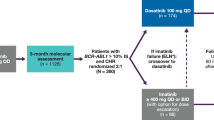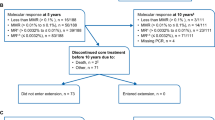Abstract
Nilotinib is a highly selective Bcr–Abl inhibitor approved for imatinib-resistant chronic myeloid leukemia (CML). Nilotinib and dasatinib, a multi-targeted kinase inhibitor also approved for second-line therapy in CML, have different patterns of kinase selectivity, pharmacokinetics, and cell uptake and efflux properties, and thus patients may respond to one following failure of the other. An international phase II study of nilotinib was conducted in CML patients (39 chronic phase (CP), 21 accelerated phase (AP)) after failure of both imatinib and dasatinib. Median times from diagnosis of CP or AP to nilotinib therapy were 89 and 83 months, respectively. Complete hematological response and major cytogenetic response (MCyR) rates in CP were 79% and 43%, respectively. Of 17 evaluable patients with CML-AP, 5 (29%) had a confirmed hematological response and 2 (12%) a MCyR. The median time to progression has not yet been reached in CP patients. At 18 months 59% of patients were progression-free. Median overall survival for both populations has not been reached, and the estimated 18-month survival rate in CML-CP was 86% and that at 12 months for CML-AP was 80%. Nilotinib is an effective therapy in CML-CP and -AP following failure of both imatinib and dasatinib therapy.
This is a preview of subscription content, access via your institution
Access options
Subscribe to this journal
Receive 12 print issues and online access
$259.00 per year
only $21.58 per issue
Buy this article
- Purchase on Springer Link
- Instant access to full article PDF
Prices may be subject to local taxes which are calculated during checkout
Similar content being viewed by others
References
Giles FJ, O′Dwyer M, Swords R . Class effects of tyrosine kinase inhibitors in the treatment of chronic myeloid leukemia. Leukemia 2009; 23: 1698–1707.
O′Hare T, Eide CA, Deininger MW . Bcr-Abl kinase domain mutations, drug resistance, and the road to a cure for chronic myeloid leukemia. Blood 2007; 110: 2242–2249.
Baccarani M, Cortes J, Pane F, Niederwieser D, Saglio G, Apperley J et al. Chronic myeloid leukemia: an update of concepts and management recommendations of European LeukemiaNet. J Clin Oncol 2009; 27: 6041–6051.
Hochhaus A, O′Brien SG, Guilhot F, Druker BJ, Branford S, Foroni L et al. Six-year follow-up of patients receiving imatinib for the first-line treatment of chronic myeloid leukemia. Leukemia 2009; 23: 1054–1061.
Quintas-Cardama A, Kantarjian H, Jones D, Nicaise C, O′Brien S, Giles F et al. Dasatinib (BMS-354825) is active in Philadelphia chromosome-positive chronic myelogenous leukemia after imatinib and nilotinib (AMN107) therapy failure. Blood 2007; 109: 497–499.
Goldman JM . Chronic myeloid leukemia: reversing the chronic phase. J Clin Oncol 2010; 28: 363–365.
Jabbour E, Hochhaus A, Cortes J, La Rosee P, Kantarjian HM . Choosing the best treatment strategy for chronic myeloid leukemia patients resistant to imatinib: weighing the efficacy and safety of individual drugs with BCR-ABL mutations and patient history. Leukemia 2010; 24: 6–12.
Hiwase DK, Saunders V, Hewett D, Frede A, Zrim S, Dang P et al. Dasatinib cellular uptake and efflux in chronic myeloid leukemia cells: therapeutic implications. Clin Cancer Res 2008; 14: 3881–3888.
Eadie L, Hughes TP, White DL . Nilotinib does not significantly reduce imatinib OCT-1 activity in either cell lines or primary CML cells. Leukemia 2010; 24: 855–857.
Hiwase DK, White D, Zrim S, Saunders V, Melo JV, Hughes TP . Nilotinib-mediated inhibition of ABCB1 increases intracellular concentration of dasatinib in CML cells: implications for combination TKI therapy. Leukemia 2010; 24: 658–660.
Acknowledgements
Research grant for this study was supplied by Novartis.
Author information
Authors and Affiliations
Corresponding author
Ethics declarations
Competing interests
Francis J Giles, Elisabetta Abruzzese, Gianantonio Rosti, Dong-Wook Kim, Ravi Bhatia, Andre Bosly, Stuart Goldberg, Grace Kam, Madan Jagasia, Wlodzimierz Mendrek, Thomas Fischer, Thierry Facon, Ulrich Dünzinger, David Marin, Martin C Mueller, Richard Larson, Francois-Xavier Mahon, Michele Baccarani, Jorge Cortes and Hagop Kantarjian have received research funding from Novartis Pharmaceuticals. Yaping Shou and Neil Gallagher are employees of Novartis Pharmaceuticals.
Rights and permissions
About this article
Cite this article
Giles, F., Abruzzese, E., Rosti, G. et al. Nilotinib is active in chronic and accelerated phase chronic myeloid leukemia following failure of imatinib and dasatinib therapy. Leukemia 24, 1299–1301 (2010). https://doi.org/10.1038/leu.2010.110
Received:
Accepted:
Published:
Issue Date:
DOI: https://doi.org/10.1038/leu.2010.110
Keywords
This article is cited by
-
The importance of personalized medicine in chronic myeloid leukemia management: a narrative review
Egyptian Journal of Medical Human Genetics (2023)
-
Matching-adjusted indirect comparison of asciminib versus other treatments in chronic-phase chronic myeloid leukemia after failure of two prior tyrosine kinase inhibitors
Journal of Cancer Research and Clinical Oncology (2023)
-
Asciminib monotherapy in patients with CML-CP without BCR::ABL1 T315I mutations treated with at least two prior TKIs: 4-year phase 1 safety and efficacy results
Leukemia (2023)
-
Emerging role of exosomes in hematological malignancies
Clinical and Experimental Medicine (2022)
-
Third-line therapy for chronic myeloid leukemia: current status and future directions
Journal of Hematology & Oncology (2021)



